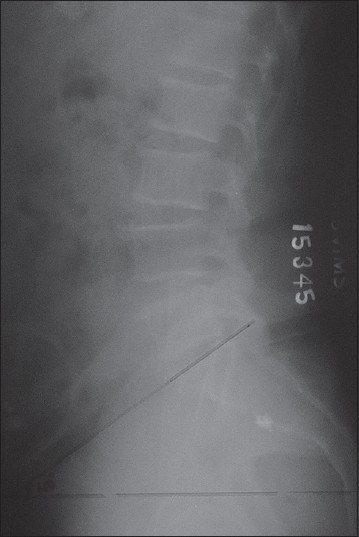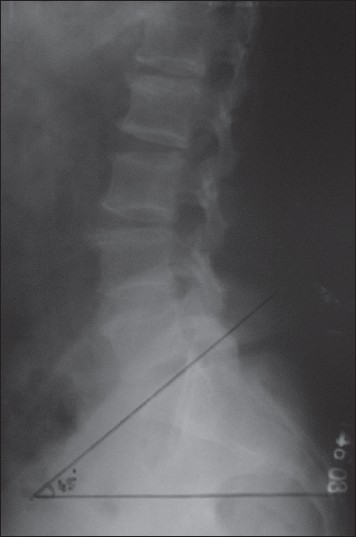Translate this page into:
Effect of exercise program on lumbosacral strain in patients on continuous ambulatory peritoneal dialysis
This is an open-access article distributed under the terms of the Creative Commons Attribution-Noncommercial-Share Alike 3.0 Unported, which permits unrestricted use, distribution, and reproduction in any medium, provided the original work is properly cited.
This article was originally published by Medknow Publications & Media Pvt Ltd and was migrated to Scientific Scholar after the change of Publisher.
Sir,
In patients on continuous ambulatory peritoneal dialysis (CAPD), a weight of 2 l (2 kg) dialysate in the peritoneal cavity causes low back strain and pain. The lumbosacral strain is assessed by measurement of lumbosacral angle (LSA) radiologically by Ferguson's technique (normal humans around 30°),[1] range of motion (ROM) of lumbar spine is by Schober's test[2] and lumbosacral discomfort through Visual Analogue Scale (VAS) scoring.
We studied 11 patients (male: female = 8:3), five were diabetic, none had disc prolapse, fracture and infections of lumbosacral spine. The assessment of these parameters were carried out on three occasions in all patients, firstly [Figure 1] when the peritoneal cavity was empty (without fluid), secondly when the peritoneal [Figure 2] cavity was filled with fluid (after infusion of CAPD bag) and thirdly 3 weeks after initiating the exercises as prescribed below. The prescribed exercises were, (a) pelvic tilt in lying, (b) abdominal curl up, (c) single knee to chest flexion with flexion and extension of knee, (d) straight leg raising with ankle dorsiflexion and (e) standing pelvic tilt.[3] The measurements of LSA, ROM and VAS score were tabulated in Table 1.

- Lumbosacral angle before continuous ambulatory peritoneal dialysis bag infusion

- Lumbosacral angle after continuous ambulatory peritoneal dialysis bag infusion

We observed by repeated measure analysis of variance statistical technique there was a statistically significant reduction in LSA and ROM of the lumbar spine and VAS score after the exercise program in comparison with the value before the initiation of exercise program.
In conclusion, we suggest that an effective exercise program applied under physiotherapy specialists’ guidance improves musculoskeletal strength of lumbosacral region to mitigate lumbosacral strain.
Acknowledgment
We thank to Dr. Vishnu Vardhan Ph.D. (Statistics) for his help in statistical data analysis of our study.
References
- Etiology prevention and treatment of back pain in patients undergoing continuous ambulatory peritoneal dialysis. Perit Dial Int. 1981;1:119-22.
- [Google Scholar]
- Measurement of the normal lumbosacral angle. Am J Roentgenol Radium Ther Nucl Med. 1971;113:642-5.
- [Google Scholar]
- Orthopedic Physical Assessment. (5th ed). St. Louis, Missouri: Saunders; 2008. p. :515-616.
- [Google Scholar]






